Even a few years ago, you’d have to be a) very rich and b) very committed to the green cause to consider a hybrid. Yes, there were some micro hybrids with start-stop tech in the mainstream segments, but the few ‘proper’ hybrids with battery packs and electric motor assist were prohibitively expensive. And with fuel-efficient – whisper it – diesel-powered options available for much less money, the case for going hybrid was weakened further. But things have changed today. For one, hybrid technology has trickled down to lower segments, so it’s possible to do your bit for the environment without having to break the bank. Then there’s the growing anti-diesel sentiment in India which is only getting louder. The uncertainty over future regulations on diesel cars has also got buyers thinking of alternatives and in the premium executive sedan segment; there are no greener and more efficient alternatives than the Toyota Camry Hybrid and new Honda Accord Hybrid.

The Hybrid marks the return of the Accord to India and also serves as a technological showcase for Honda – we’ll get to the details in a bit. Built in Japan and shipped here, the fully imported Accord Hybrid unfortunately and perhaps unfairly is subject to the full spectrum of Indian taxes and duties though and what that means is it costs a hefty Rs 37 lakh (ex-showroom, Delhi). Toyota, on the other hand, assembles the Camry Hybrid at its plant in Karnataka which qualifies the sedan for incentives under the government’s Faster Adoption and Manufacturing of (Hybrid and) Electric Vehicles in India or FAME India scheme. Resultantly, it’s available for a far more reasonable Rs 30.9 lakh.
On price alone, the Camry has the Accord beat. But it would be a grave injustice to reach a final conclusion without seeing the entire picture. Could the Accord Hybrid have some surprises in store? Or is the Camry Hybrid all the hybrid premium executive sedan you’d need?
Hybrid theory
Let’s begin by delving into what makes these cars special to begin with – their powertrains. Both the Accord and the Camry hybrids have internal combustion engines and electric motors that combine to form single drive systems; so at one level, they are similar. Both also use piston engines that run the more efficient Atkinson cycle. But get into the details and both systems are very different.
The Toyota system on the Camry comprises a 160hp 2.5-litre four-cylinder petrol and 105kW (143hp) electric motor. The Camry can run in full electric mode only at low speeds and on mild throttle inputs. Up the pace and the system switches to a combination of electric and engine power (for a total output of 205hp), both sources driving the front wheels via a CVT gearbox. The 6.5Ah battery pack gets its power via regeneration, that is when the car is slowing down or cruising.
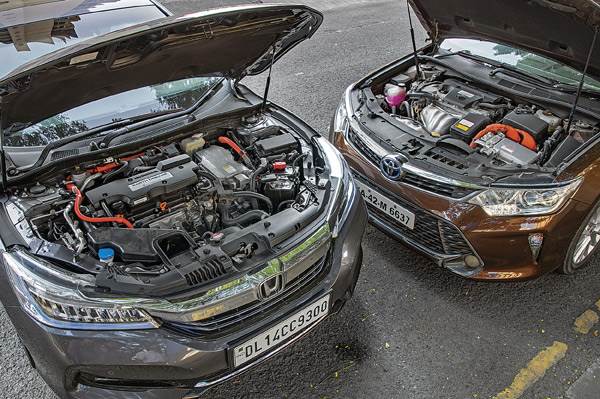
The Accord’s system is quite radical. It uses a lower-powered 145hp 2.0-litre petrol but a more peppy 135kW (184hp) electric motor. The real talking points, however, are the car’s three drive modes. The first, EV mode has the Accord running solely on electric power drawn from the battery. As the battery depletes and/or speeds increase, the system switches to Hybrid mode. Here, the engine steps in, but not to drive the front wheels directly but to power a generator for the electric motor. So, in effect, in this mode the Accord functions as a range extender with motive power still supplied by the electric motor. Where the Honda also differs is how it uses its petrol motor. The latter only connects with the front wheels at around 80kph or so when the system switches to the third, Engine mode. When this happens, a clutch locks the engine to the front wheels. The electric motor is only used to add power in extreme circumstances, such as when you go flat on the throttle. And then you get a total of 215hp.
Since the engine only directly powers the driven wheels at cruising speeds and above, Honda has uniquely opted to use only a single-speed transmission with the gear (ratio) in question equivalent to a regular gearbox’s fifth or sixth gear. The advantage of this arrangement is minimal mechanical losses vis-à-vis a traditional transmission.
That’s the tech. But how are they from behind the wheel? Expectantly, both cars run silently on electric power but it’s the Honda that is clearly quicker to replenish its batteries in average city driving. As a result, it’s also the car that goes longer in full EV mode. The caveat here is you have to be very gentle with throttle inputs to keep the Accord running as an electric vehicle. Press down any harder on the throttle pedal and the engine comes to life with the system switching to Hybrid mode. Also, when the Honda engine does kick in, you can tell it’s the noisier one here. It also tends to groan when extended. While you will rarely have the Accord go into Engine mode in city conditions, what’s remarkable is how seamless the transition is from Hybrid to Engine mode. So much so that you can’t pinpoint the moment when the engine takes over as the primary source of propulsion from the electric motor.
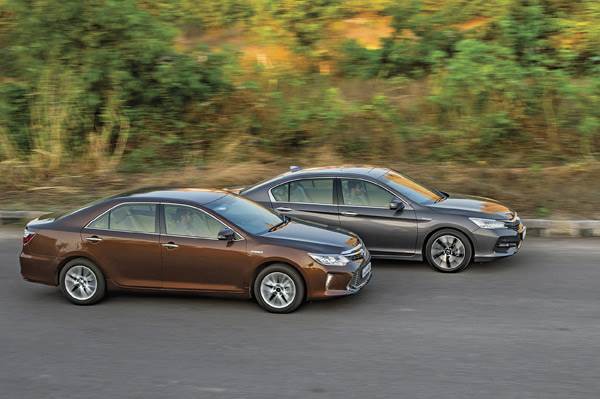
The Camry may not have the Accord’s electric range but its EV mode does allow you to be a bit more liberal with throttle inputs before it hands over the reins to the engine. The Toyota engine itself runs quietly for the most part but get the Camry excited and there’s no escaping that there’s a CVT in the picture – revs rise faster than a corresponding rise in speed.
Both cars offer more than adequate performance in town but it’s the Accord that always feels a little bit more eager on the move. The Honda is also the only one here with a Sport mode that quickens up responses. Against the clock too, it was the Accord that was faster with a 0-100kph time of 8.32sec to the Camry’s time of 9.2sec. However, acceleration figures don’t help sell hybrid cars. Fuel economy figures do. And it’s here more than anywhere else that the Accord really shines. Its 17.4kpl city fuel efficiency not only significantly betters the Camry’s respectable 14.1kpl figure, but is also among the best we’ve ever recorded for a petrol car! The Accord’s exceptional fuel economy is all thanks to the engine playing no more than a supporting role to the electric motor in typical city driving conditions. Both cars did well on our highway cycle too, but once again the Accord, whose electric motor chips in during steady cruising, proved far more efficient.
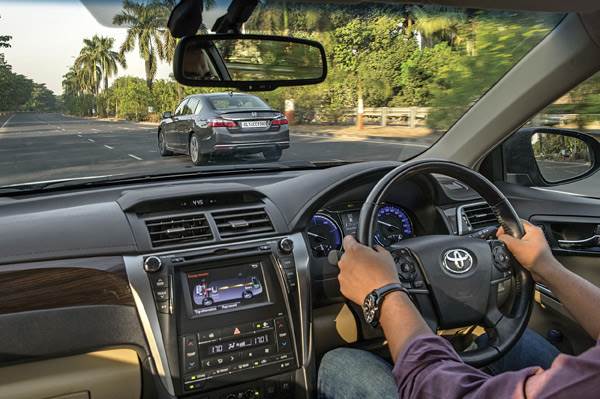
Efficient, green and powerful as these cars are, they are not exciting. They don’t change direction with particular gusto and their steerings don’t offer enough to excite the keen driver. There isn’t all that much between the duo in ride comfort either. The Accord has the marginally nicer low-speed ride and also feels a touch more planted at higher speeds.
Luxury quotient
As premium executive sedans, these cars better offer comfort and space in abundance. And they do. The Honda has the nicer back seat and offers the sofa-like comfort Accords of the past were famous for. Sure, seat cushioning is on the softer side but the seating position is better than what you get in the Camry and the ambience inside is nicer too. The Camry seats rear occupants lower resulting in a slightly knees-up seating position. There is, however, more headroom on offer, a far more usable middle seat and also the option to electrically recline the outer seat’s backrests by up to eight degrees. The Camry and the Accord do give the option to adjust the front passenger seat from the back to free up more legroom.
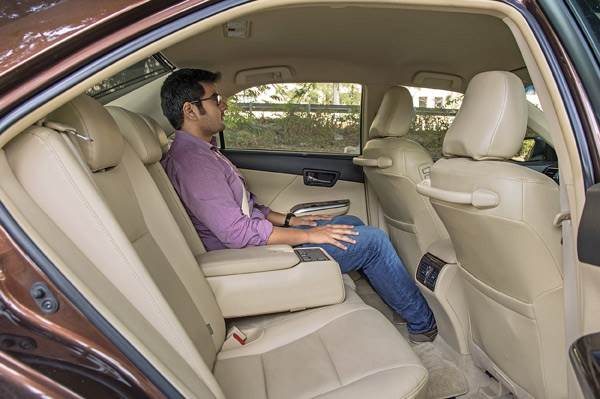
What both cars also offer are comfortable and rather generous-sized front seats. Still, you’ll have a higher opinion of the Accord’s cabin. It is far better finished and the multi-layer dash, replete with dual screens, also has a more modern air about it. Like the Camry there’s no tachometer on the Accord. But unlike the Camry, it doesn’t really need one. Remember, the engine only comes into play to drive the wheels at higher speeds. The speedo dial and information displays do add to the look. There’s also a certain feeling of solidity that the thunk on door shut imparts.
The Camry is well built too, but the cabin just doesn’t feel special enough for the price. The dash isn’t anything out of the ordinary, the touchscreen looks like an aftermarket add-on and there’s way too much shiny faux wood and too many plain buttons in what should be a premium cabin. The old-school shift gate is also at odds with the modern instrument cluster that houses a colour display that tells the source of propulsion in real time.
What Toyota has done is equipped the Camry Hybrid rather well. In addition to the adjustable rear-seat backrests mentioned earlier, there’s also three-zone climate control, audio controls in the rear armrest, electric rear sun shade, ventilated front seats and powered steering adjust. The Accord has some highlights of its own too. Its driver’s seat gets a memory function, there’s a sunroof, satellite navigation is standard, and the infotainment system also comes with Android Auto and Apple CarPlay. Both cars get seven airbags and a whole host of electronic safety aids. The Accord additionally features what Honda calls LaneWatch. Here, the centre screen relays images from the left side mirror thus giving a visual of any blind spots.
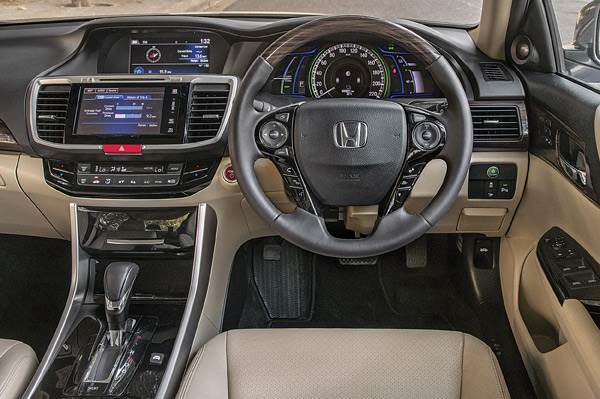
An important point to bring in is that only the Camry features a full-size spare tyre. Honda only supplies a puncture repair kit with the Accord Hybrid. Even so, it’s the Accord that has the marginally smaller boot with the battery pack eating into luggage space.
The final countdown
Before we tally the scores, a word on the way these cars look. The Camry is smart but some of us think the cuts and creases at the front are unnecessary. The Accord on the other hand has the sleeker look and generally sportier stance.
Truth is, the Accord Hybrid is also the more desirable car. It feels newer, it’s got the nicer interior and it’s got the sort of technology under its attractive skin that other hybrids will only receive in the years to come. And for what it’s worth, it’s also the more fuel-efficient car. But good as the Accord Hybrid is, it’s not good enough to justify the Rs 7 lakh premium over the Camry.

The Camry Hybrid may be down on appeal but it works well as a hybrid and there’s just no arguing the financial case it makes. It really is the more sensible buy and our pick of this duo.
Could local assembly and a subsequent lower price tag have changed the outcome of this comparison in favour of the Honda? Most definitely, yes.
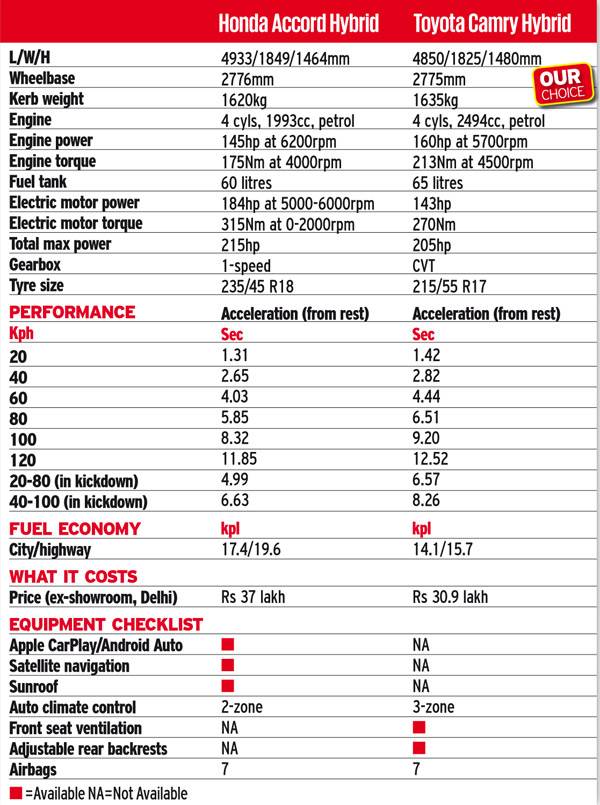







Comments
Member Login
Personal Details
No comments yet. Be the first to comment.